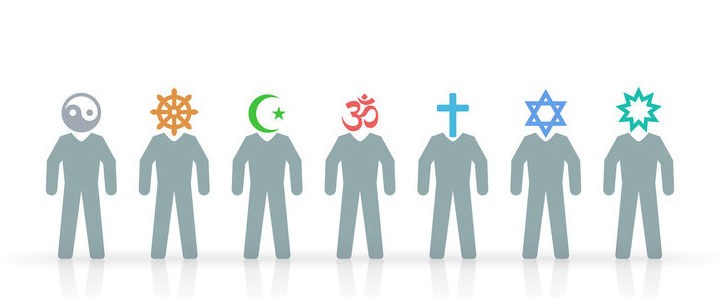“Secularism” often functions as a catch-all bugaboo for religious circles in the United States, and concerns that culture is becoming increasingly secular raise fears among American Christians in particular.
In the case of public education, there remains a myth that public, secular instruction runs counter to religious, sectarian instruction. Seeing these two forms of education as opposites, however, fuels a great deal of misunderstanding about the goals of “secular” education.
What is secularism anyway?
One of the biggest problems with conversations in the United States about secularism is that secularism is not a static category. For many Americans, the “secular” functions as an adjective describing something that is void of religion, or perhaps the term describes a public realm or space characterized by the absence of religion.
Another approach to secularism might welcome representation of all religious traditions, much like “coexist” or “tolerance” bumper stickers. By giving equal representation to all religions, this approach to secularism claims to be neutral. By neither privileging nor inhibiting certain religions, the “secular” strives to be neutral toward religion.
“In the eyes of many Americans, however, this idea of neutrality looks more like hostility.”
In the eyes of many Americans, however, this idea of neutrality looks more like hostility. By removing religion from the equation, the “secular” becomes antagonistic toward religion. It seeks to erase or suppress religious expression. In this way, the “secular” might be understood by some as a competing ideology that seeks to oppress religious belief and practice.
Many secularisms
Because of the fluidity of the term, not all countries share a common understanding or approach to secularism. A schoolteacher in France was brutally murdered recently by a terrorist angered by classroom displays of caricatures of the prophet Muhammad. The teacher’s death likely will renew conversation regarding the country’s strict approach to secular governance and freedom of expression.
One educational leader in France explained: “The situation has become so tense in our country over the issues of secularism and Islam that it’s become impossible to have a reasonable conversation.”
Rather than viewing the sectarian and the secular as competing ideologies, many scholars, however, see the “secular” as a type of system designed to organize a multiplicity of competing religious beliefs and practices. In a society with numerous religious traditions, some of which hold intense animosity toward one another, the secular attempts to keep the peace by establishing laws and spaces of governance where religion ought not operate.
Understanding the secular as a system designed to keep the peace in a multi-religious country helps explain variations in the implementation of secularism. At times, it may be necessary for the secular to oppress certain religious beliefs and practices in order to keep peace. In the same breath, however, the secular may afford religious traditions special privileges, for instance the ability to discriminate in certain ways when hiring ministers. As religions change and grow, secularism adapts to manage potential conflicts and maintain a collective identity among a country’s citizenry.
A ‘Protestant Secular’
If the “secular” functions as a system of organizing religious belief and practices, there are ways in which this system might benefit (either intentionally or unintentionally) certain religious traditions over others. Within the United States, the religious tradition that has most benefited from our secular government has been Protestantism specifically and Christianity generally.
“Within the United States, the religious tradition that has most benefited from our secular government has been Protestantism specifically and Christianity generally.”
Public schools in the 19th century used non-sectarian readings from the King James Version of the Bible. Rather than select readings that might favor Presbyterians over Methodists or Baptists over Congregationalists, non-sectarian readings sought to keep the peace between these Christian sects. At the same time, the choice of the King James Version over the Roman Catholic Douay Bible privileged Protestantism over Roman Catholicism. This was a secular approach to public education; however, it greatly privileged Protestantism over Roman Catholicism or any other religious tradition.
The 1962 landmark Supreme Court Case regarding Bible reading in public schools, Abington v. Schempp, still provides guidance for differentiating between secular and sectarian education. Justices Goldberg and Harlan provided the most memorable aphorism from the court’s decision in an opinion concurring with the majority. Prepositions became the sticking point. The two justices reasoned: “Teaching about religion, as distinguished from the teaching of religion” remained constitutional. The secular teaching about religion was permissible, whereas the confessional teaching of religion was unconstitutional.
Another concurring opinion by Justice Brennan, however, provided a little more nuance to the differentiation between religious and secular education. He argued that the “state acts unconstitutionally if it either sets about to attain even indirectly religious ends by religious means, or if it uses religious means to serve secular ends where secular means would suffice.” Brennan acknowledged that secular and religious agendas can overlap, and he suggested that the secular means and ends must take priority in the case of public education.
Sometimes disentangling and parsing the religious and secular ends can be difficult, but doing so is important for understanding how often times rooted within American secular education is a Christian bias.
What about a World religions course?
Teaching a class on world religions, for instance, might seem like a secular endeavor. A closer look at the history and legacy of this course reveals a deeply Christian centric root. Tomoko Masuzawa’s The Invention of World Religions interrogates the way 19th century Christian scholars developed a world religions curricular format based on their own knowledge and belief in Christianity.
Much of the initial desire to understand “world religions” in the 19th century stemmed from the emerging missionary movement. Christians who desired to convert the “heathen” sought to understand the religious beliefs and practices of the various cultures of the world. By understanding religious practices around the world, Christians might be better suited to convert persons who believed differently from them.
These 19th century scholars used Christianity as the measuring stick for evaluating these “religions.” Did the observed “religion” have a sacred text, a supreme deity or other similar elements to Christianity? How was it dissimilar to Christianity? In raising these Christian-centric questions, scholars began to characterize some systems of belief and practice as more sophisticated and others as more primitive. For these mostly European and American scholars, Christianity remained the most advanced.
Early constructions of this “world religions paradigm” for many Christians sought to aid in conversion activities. The Society for Missionary Inquiry at Union Theological Seminary in New York City studied a basic world religions curriculum in the 1840s as students considered whether or not they were called to the mission field.
By the 20th century, however, less evangelistic and missionary-minded Protestants saw world religion courses as an opportunity to promote peace and tolerance among the various religions of the world. Students could learn about and appreciate cultural differences to promote common understanding.
While teaching a world religions course may be the secular standard bearer for departments of religion in colleges and universities, the history and creation of this course tells another story. Such a course privileges Christianity and religious traditions with similar features while disadvantaging those traditions most dissimilar from Christianity.
Establishing a common identity
“Secular education is continuously attempting to strike a balance between many competing visions and understandings of the world.”
Perhaps the most significant difference between secular and sectarian approaches to education results from the reality that secular education is never completely realized. Secular education is continuously attempting to strike a balance between many competing visions and understandings of the world. Sometimes secular education strikes this balance better than at other times, but the goal remains to orient a multi-religious society toward a common goal, a common identity.
Today, pleas for sectarian, private education suggest a more combative and antagonistic mode. The desire for consensus and working toward a common goal has been replaced by an uncompromising spirit that refuses to engage in cooperative and mutual understanding between individuals of differing points of view. While this may be more difficult to see from a religious perspective, politically we see this quite clearly.
In many ways, secular education is deeply religious. The objective of organizing a multi-religious society to work together peaceably and cooperatively is rooted with an understanding of the Golden Rule. The mandate to treat others as you would like to be treated rings throughout numerous religious traditions. Secular education strives to implement the Golden Rule on a societal level.
The question of secular vs. sectarian education in this moment might be reduced to whether or not we as a society desire to work together toward common goals that cut beyond our different understandings of the world. Do American Christians, Jews, Muslims, Hindus, Atheists and “nones” desire to live and learn together? Do Republicans and Democrats?
 Andrew Gardner is visiting faculty associate in American religious history and Louisville Institute Postdoctoral Research Fellow at Hartford Seminary, Hartford Institute for Religion Research.
Andrew Gardner is visiting faculty associate in American religious history and Louisville Institute Postdoctoral Research Fellow at Hartford Seminary, Hartford Institute for Religion Research.
Related articles:
Baptist group says cross is not secular, and government has no business sponsoring its display


